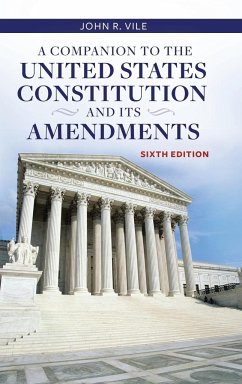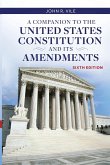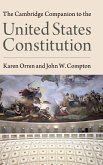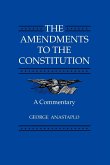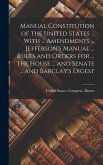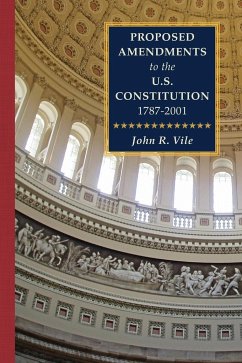John Vile
A Companion to the United States Constitution and Its Amendments
John Vile
A Companion to the United States Constitution and Its Amendments
- Gebundenes Buch
- Merkliste
- Auf die Merkliste
- Bewerten Bewerten
- Teilen
- Produkt teilen
- Produkterinnerung
- Produkterinnerung
Now in its sixth edition with coverage of major Supreme Court decisions through the end of the 2013-2014 term, this book remains a key source for students, professors, and citizens seeking balanced, up-to-date information on the Constitution, its amendments, and how they have been interpreted. A document that is well past two centuries old, the U.S. Constitution remains as relevant and important today as during the time of our country's founding. Now in its sixth edition, this single-volume work offers a fair, non-partisan treatment of one of the most important documents in American history.…mehr
Andere Kunden interessierten sich auch für
![A Companion to the United States Constitution and Its Amendments A Companion to the United States Constitution and Its Amendments]() John VileA Companion to the United States Constitution and Its Amendments44,99 €
John VileA Companion to the United States Constitution and Its Amendments44,99 €![The Cambridge Companion to the United States Constitution The Cambridge Companion to the United States Constitution]() The Cambridge Companion to the United States Constitution115,99 €
The Cambridge Companion to the United States Constitution115,99 €![The Amendments to the Constitution The Amendments to the Constitution]() George AnastaploThe Amendments to the Constitution34,99 €
George AnastaploThe Amendments to the Constitution34,99 €![Manual Constitution of the United States ... With ... Amendments ... Jefferson's Manual ... Rules and Orders for ... the House ... and Senate ... and Barclay's Digest Manual Constitution of the United States ... With ... Amendments ... Jefferson's Manual ... Rules and Orders for ... the House ... and Senate ... and Barclay's Digest]() Manual Constitution of the United States ... With ... Amendments ... Jefferson's Manual ... Rules and Orders for ... the House ... and Senate ... and Barclay's Digest37,99 €
Manual Constitution of the United States ... With ... Amendments ... Jefferson's Manual ... Rules and Orders for ... the House ... and Senate ... and Barclay's Digest37,99 €![The Edinburgh Companion to the Politics of American Health The Edinburgh Companion to the Politics of American Health]() The Edinburgh Companion to the Politics of American Health249,99 €
The Edinburgh Companion to the Politics of American Health249,99 €![Proposed Amendments to the U.S. Constitution 1787-2001 Proposed Amendments to the U.S. Constitution 1787-2001]() Proposed Amendments to the U.S. Constitution 1787-200185,99 €
Proposed Amendments to the U.S. Constitution 1787-200185,99 €![The Cambridge Companion to Nelson Mandela The Cambridge Companion to Nelson Mandela]() The Cambridge Companion to Nelson Mandela90,99 €
The Cambridge Companion to Nelson Mandela90,99 €-
-
-
Now in its sixth edition with coverage of major Supreme Court decisions through the end of the 2013-2014 term, this book remains a key source for students, professors, and citizens seeking balanced, up-to-date information on the Constitution, its amendments, and how they have been interpreted. A document that is well past two centuries old, the U.S. Constitution remains as relevant and important today as during the time of our country's founding. Now in its sixth edition, this single-volume work offers a fair, non-partisan treatment of one of the most important documents in American history. The book begins with introductory background information on the U.S. Constitution and the Declaration of Independence and then presents a clause-by-clause explanation of the Constitution from the preamble through all of its amendments, addressing how each has been interpreted by the U.S. Supreme Court and other institutions throughout U.S. history. This fully updated edition of A Companion to the United States Constitution and Its Amendments incorporates numerous new developments in the four years since the previous edition, including the appointments of new Supreme Court justices, impactful cases involving First Amendment rights for students, the Affordable Care Act, National Security Agency (NSA) data gathering, voting rights, campaign finance law, DNA sampling, and the ongoing battle over gay rights. As with the previous editions, John R. Vile provides a balanced and thorough treatment that identifies key Supreme Court decisions and other interpretations of the document while abstaining from unnecessarily complex and confusing explanations.
Produktdetails
- Produktdetails
- Verlag: Bloomsbury Publishing plc
- Seitenzahl: 344
- Erscheinungstermin: 28. Februar 2015
- Englisch
- Abmessung: 240mm x 161mm x 23mm
- Gewicht: 681g
- ISBN-13: 9781440833274
- ISBN-10: 1440833273
- Artikelnr.: 41417130
- Herstellerkennzeichnung
- Libri GmbH
- Europaallee 1
- 36244 Bad Hersfeld
- gpsr@libri.de
- Verlag: Bloomsbury Publishing plc
- Seitenzahl: 344
- Erscheinungstermin: 28. Februar 2015
- Englisch
- Abmessung: 240mm x 161mm x 23mm
- Gewicht: 681g
- ISBN-13: 9781440833274
- ISBN-10: 1440833273
- Artikelnr.: 41417130
- Herstellerkennzeichnung
- Libri GmbH
- Europaallee 1
- 36244 Bad Hersfeld
- gpsr@libri.de
John R. Vile
Preface to the Seventh Edition
Acknowledgments
Chapter 1The Background and Purposes of the Constitution
The Colonial Setting The Declaration of Independence The Background of the
Declaration The Purpose of the Document The Idea of Equality of Human
Rights The Purpose of Government The Right of Revolution Charges against
the English King Indictments against the King and the Parliament War
Atrocities and Slavery Recapitulation of Earlier Petitions Conclusion The
Articles of Confederation The Background The Principles and Structures The
Achievements and Problems Prelude to the Constitutional Convention The
Constitutional Convention The Delegates The Rules The Virginia Plan The New
Jersey Plan Prominent Convention Issues and Compromises Ratification of the
Constitution The Preamble The Purposes of the Constitution Summary For
Reflection and Discussion References and Suggestions for Further Study
Chapter 2 Article I: The Legislative Branch
The Outline of the Constitution and Separation of Powers The Priority of
the Legislative Branch Bicameralism The U.S. House of Representatives Terms
of Office and Qualifications for Voters Qualifications for the House
Representation and Taxation The Three-Fifths Clause U.S. Census Initial
State Representation House Vacancies The Speaker of the House The Power of
Impeachment The U.S. Senate Representation, Voting, and Terms Staggered
Senate Terms and Vacancies Qualifications for the Senate The Legislative
Role of the Vice President Other Senate Officers Trials of Impeachment The
Consequences of Impeachment Other Matters Involving Congressional
Operations Elections for Congress Housekeeping Provisions Congressional
Compensation Congressional Privilege The Ineligibility Clause Article I,
Section 7-Procedures for Passing Laws The Origination Clause Procedures for
Lawmaking and Presidential Vetoes The Presentment Clause Article I, Section
8-Powers Granted to Congress The Power of the Purse Power to Regulate
Commerce A Note on Native Americans Power over Naturalization Power over
Bankruptcies Coining Money and Establishing Uniform Standards Establishing
a Post Office and Promoting Scientific Advances Establishing Lower Courts
War Powers Calling the Militia Governing the District of Columbia Implied
Powers Congressional Investigations Article I, Section 9-Limits on
Congressional Powers Slave Importation The Suspension Clause and the Writ
of Habeas Corpus Bills of Attainder and Ex Post Facto Laws Economic
Protections for the States The Appropriation of Money Limits on Titles of
Nobility and Foreign Emoluments Article I, Section 10-Limits on the States
Powers Reserved to the National Government The Contract Clause Other
Economic Limits on the States Summary For Reflection and Discussion
References and Suggestions for Further Study
Chapter 3Article II: The Executive Branch
A Single Executive The Presidential Term Presidential Selection and the
Electoral College Presidential Qualifications The Vice President and
Presidential Disability The Presidential Salary The Presidential Oath
Presidential Duties Commander in Chief Getting Advice from the Cabinet
Power to Pardon and Reprieve Negotiation and Ratification of Treaties
Presidential Appointment and Removal Powers Recess Appointments Clause The
State of the Union Address Power to Convene and Adjourn Congress The
President as Chief Diplomat Power to Execute the Laws and Executive
Privilege Commissioning of Military Officers Presidential Impeachment
Censure Executive Orders and Presidential Signing Statements Summary For
Reflection and Discussion References and Suggestions for Further Study
Chapter 4Article III: The Judicial Branch
Organization and Guidelines The U.S. Supreme Court and Other Inferior
Courts Judicial Tenure Judicial Qualifications Judicial Compensation The
Number of Justices Supreme Court Decisions Jurisdiction Cases Based on
Subject Matter and Parties to the Suit Cases of Original and Appellate
Jurisdiction Limits on the Judicial Branch The Political Questions Doctrine
Judicial Powers Statutory Interpretation and Judicial Review Marbury v.
Madison Judicial Review in Practice The Exceptions Clause Protections Trial
by Jury Treason The Nature of Article III Summary For Reflection and
Discussion References and Suggestions for Further Study
Chapter 5Article IV: The Federal System
Three Forms of Government Layer Cake or Marble Cake? Obligations of States
to One Another The Full Faith and Credit Clause The Privileges and
Immunities Clause Extradition The Fugitive Slave Clause The Admission of
New States Governing the Territories Obligations of the Nation to the
States The Guarantee Clause Rejected Doctrines of Federalism Interposition
Nullification Secession The Status of Local Governments Summary For
Reflection and Discussion References and Suggestions for Further Study
Chapter 6Articles V-VII: The Amending Provision and Miscellaneous Matters
Amending Procedures The Most Common Route for Proposal and Ratification The
Unused Convention Mechanism Rescissions and Time Limits Is the Amending
Process Exclusive? Entrenchment Clauses The History of Amendments in the
United States Article VI The Continuing Validity of Debts The Supremacy
Clause Oaths of Office and Prohibition of Religious Tests Article VII
Ratification of the Constitution The Attestation Clause Summary For
Reflection and Discussion References and Suggestions for Further Study
Chapter 7The Bill of Rights-The First Amendment
Background Application of the Bill of Rights The Bill of Rights: A Floor or
a Ceiling? The Idea of Rights The Placement of the First Amendment The
Establishment and Free Exercise Clauses References to God The Three-Part
Lemon Test and the Wall of Separation Application of the Establishment
Clause to Schools In Other Contexts The Free Exercise Clause and the
Belief/Practice Dichotomy Application of the Free Exercise Clause Freedom
of Speech Justifications for Freedom of Speech Tests for Subversive Speech
Subsidiary Principles Obscenity Symbolic Speech Fighting Words and True
Threats Libel Commercial Speech Campaign Contributions Freedom of the Press
Prior Restraint Other Press Issues Additional First Amendment Rights
Assembly, Association, and Petition Summary For Reflection and Discussion
References and Suggestions for Further Study
Chapter 8The Bill of Rights: Of Arms and Men-Amendments 2-3
The Second Amendment Right to Bear Arms Rival Interpretations Modern
Militia Groups The Third Amendment The Prohibition against Quartering
Troops Summary For Reflection and Discussion References and Suggestions for
Further Study
Chapter 9The Bill of Rights and the Rights of the Accused and the
Convicted-Amendments 4-8
The Fourth Amendment and Searches and Seizures An Amendment in Two Parts
The Reasonableness Requirement Excessive Use of Force Warrant Requirements
Administrative Searches The Exclusionary Rule The Fifth Amendment
Indictment by Grand Jury The Double Jeopardy Provision Protection against
Self-Incrimination Physical Evidence versus Testimonial Evidence The Due
Process Clause The Takings Clause The Sixth Amendment Speedy and Public
Trials Right to a Petit Jury The Rights of Notification, Confrontation, and
Compulsory Process The Right to Counsel The Seventh Amendment Petit Juries
in Common-Law Cases The Reexamination Clause The Eighth Amendment Bail and
Fines Capital Punishment Recidivism Laws and Proportionality Concerns
Summary For Reflection and Discussion References and Suggestions for
Further Study
Chapter 10The Bill of Rights, the Rights of the States (Amendments 9-10),
and Amendments 11 and 12
The Ninth Amendment Origins Two Prominent Views of the Amendment Birth
Control and Abortion Other Privacy Issues The Tenth Amendment States'
Rights The Eleventh Amendment Suits against the States The Twelfth
Amendment The Electoral College Nomination Processes Postscript to the
Elections of 2000 and 2020 Summary For Reflection and Discussion References
and Suggestions for Further Study
Chapter 11The Post-Civil War Amendments-Amendments 13-15
Background The Thirteenth Amendment The End of Slavery The Fourteenth
Amendment Citizenship Provisions Three Important Guarantees Supreme Court
Decisions Limiting the Impact of the Fourteenth Amendment Brown and the
Rebirth of the Fourteenth Amendment School Busing and Affirmative Action
Programs Equal Protection and Gender-Based Classifications Equal Protection
and Other Classifications Equal Protection and Legislative Apportionment A
Rebirth of the Due Process Clause? Reversing the Three-Fifths Clause
Restrictions on Former Rebels Valid and Invalid Public Debts Enforcement of
the Fourteenth Amendment The Fifteenth Amendment Racially Discriminatory
Voting The Lesson of the Postwar Amendments Summary For Reflection and
Discussion References and Suggestions for Further Study
Chapter 12The Progressive Era Amendments-Amendments 16-19
The Sixteenth Amendment The National Income Tax The Seventeenth Amendment
The Election of U.S. Senators The Eighteenth Amendment The National
Prohibition of Alcohol The Nineteenth Amendment Women's Suffrage Summary
For Reflection and Discussion References and Suggestions for Further Study
Chapter 13The Recent Amendments-Amendments 20-27
The Twentieth Amendment Lame Ducks Presidential Vacancies The Twenty-first
Amendment The Repeal of National Alcohol Prohibition The Twenty-second
Amendment A Limit on Presidential Terms of Office The Twenty-third
Amendment Electoral Votes for the District of Columbia The Twenty-fourth
Amendment The Prohibition of Poll Taxes The Twenty-fifth Amendment
Vacancies and Disabilities Vacancies in the Vice Presidency Cases of
Presidential Disability The Twenty-sixth Amendment Eighteen-Year-Olds and
the Right to Vote The Twenty-seventh Amendment Congressional Pay Raises
Author's Postscript on the American Future Summary For Reflection and
Discussion References and Suggestions for Further Study
Reading Supreme Court Decisions
Locating Cases and Understanding Citations Briefing Cases Fifty Case Names
and Decisions
Glossary
Highlights of Constitutional History
U.S. Supreme Court Justices
Appendix 1: The Constitution of the United States
Appendix 2: The Declaration of Independence
Appendix 3: The Articles of Confederation
Index
Acknowledgments
Chapter 1The Background and Purposes of the Constitution
The Colonial Setting The Declaration of Independence The Background of the
Declaration The Purpose of the Document The Idea of Equality of Human
Rights The Purpose of Government The Right of Revolution Charges against
the English King Indictments against the King and the Parliament War
Atrocities and Slavery Recapitulation of Earlier Petitions Conclusion The
Articles of Confederation The Background The Principles and Structures The
Achievements and Problems Prelude to the Constitutional Convention The
Constitutional Convention The Delegates The Rules The Virginia Plan The New
Jersey Plan Prominent Convention Issues and Compromises Ratification of the
Constitution The Preamble The Purposes of the Constitution Summary For
Reflection and Discussion References and Suggestions for Further Study
Chapter 2 Article I: The Legislative Branch
The Outline of the Constitution and Separation of Powers The Priority of
the Legislative Branch Bicameralism The U.S. House of Representatives Terms
of Office and Qualifications for Voters Qualifications for the House
Representation and Taxation The Three-Fifths Clause U.S. Census Initial
State Representation House Vacancies The Speaker of the House The Power of
Impeachment The U.S. Senate Representation, Voting, and Terms Staggered
Senate Terms and Vacancies Qualifications for the Senate The Legislative
Role of the Vice President Other Senate Officers Trials of Impeachment The
Consequences of Impeachment Other Matters Involving Congressional
Operations Elections for Congress Housekeeping Provisions Congressional
Compensation Congressional Privilege The Ineligibility Clause Article I,
Section 7-Procedures for Passing Laws The Origination Clause Procedures for
Lawmaking and Presidential Vetoes The Presentment Clause Article I, Section
8-Powers Granted to Congress The Power of the Purse Power to Regulate
Commerce A Note on Native Americans Power over Naturalization Power over
Bankruptcies Coining Money and Establishing Uniform Standards Establishing
a Post Office and Promoting Scientific Advances Establishing Lower Courts
War Powers Calling the Militia Governing the District of Columbia Implied
Powers Congressional Investigations Article I, Section 9-Limits on
Congressional Powers Slave Importation The Suspension Clause and the Writ
of Habeas Corpus Bills of Attainder and Ex Post Facto Laws Economic
Protections for the States The Appropriation of Money Limits on Titles of
Nobility and Foreign Emoluments Article I, Section 10-Limits on the States
Powers Reserved to the National Government The Contract Clause Other
Economic Limits on the States Summary For Reflection and Discussion
References and Suggestions for Further Study
Chapter 3Article II: The Executive Branch
A Single Executive The Presidential Term Presidential Selection and the
Electoral College Presidential Qualifications The Vice President and
Presidential Disability The Presidential Salary The Presidential Oath
Presidential Duties Commander in Chief Getting Advice from the Cabinet
Power to Pardon and Reprieve Negotiation and Ratification of Treaties
Presidential Appointment and Removal Powers Recess Appointments Clause The
State of the Union Address Power to Convene and Adjourn Congress The
President as Chief Diplomat Power to Execute the Laws and Executive
Privilege Commissioning of Military Officers Presidential Impeachment
Censure Executive Orders and Presidential Signing Statements Summary For
Reflection and Discussion References and Suggestions for Further Study
Chapter 4Article III: The Judicial Branch
Organization and Guidelines The U.S. Supreme Court and Other Inferior
Courts Judicial Tenure Judicial Qualifications Judicial Compensation The
Number of Justices Supreme Court Decisions Jurisdiction Cases Based on
Subject Matter and Parties to the Suit Cases of Original and Appellate
Jurisdiction Limits on the Judicial Branch The Political Questions Doctrine
Judicial Powers Statutory Interpretation and Judicial Review Marbury v.
Madison Judicial Review in Practice The Exceptions Clause Protections Trial
by Jury Treason The Nature of Article III Summary For Reflection and
Discussion References and Suggestions for Further Study
Chapter 5Article IV: The Federal System
Three Forms of Government Layer Cake or Marble Cake? Obligations of States
to One Another The Full Faith and Credit Clause The Privileges and
Immunities Clause Extradition The Fugitive Slave Clause The Admission of
New States Governing the Territories Obligations of the Nation to the
States The Guarantee Clause Rejected Doctrines of Federalism Interposition
Nullification Secession The Status of Local Governments Summary For
Reflection and Discussion References and Suggestions for Further Study
Chapter 6Articles V-VII: The Amending Provision and Miscellaneous Matters
Amending Procedures The Most Common Route for Proposal and Ratification The
Unused Convention Mechanism Rescissions and Time Limits Is the Amending
Process Exclusive? Entrenchment Clauses The History of Amendments in the
United States Article VI The Continuing Validity of Debts The Supremacy
Clause Oaths of Office and Prohibition of Religious Tests Article VII
Ratification of the Constitution The Attestation Clause Summary For
Reflection and Discussion References and Suggestions for Further Study
Chapter 7The Bill of Rights-The First Amendment
Background Application of the Bill of Rights The Bill of Rights: A Floor or
a Ceiling? The Idea of Rights The Placement of the First Amendment The
Establishment and Free Exercise Clauses References to God The Three-Part
Lemon Test and the Wall of Separation Application of the Establishment
Clause to Schools In Other Contexts The Free Exercise Clause and the
Belief/Practice Dichotomy Application of the Free Exercise Clause Freedom
of Speech Justifications for Freedom of Speech Tests for Subversive Speech
Subsidiary Principles Obscenity Symbolic Speech Fighting Words and True
Threats Libel Commercial Speech Campaign Contributions Freedom of the Press
Prior Restraint Other Press Issues Additional First Amendment Rights
Assembly, Association, and Petition Summary For Reflection and Discussion
References and Suggestions for Further Study
Chapter 8The Bill of Rights: Of Arms and Men-Amendments 2-3
The Second Amendment Right to Bear Arms Rival Interpretations Modern
Militia Groups The Third Amendment The Prohibition against Quartering
Troops Summary For Reflection and Discussion References and Suggestions for
Further Study
Chapter 9The Bill of Rights and the Rights of the Accused and the
Convicted-Amendments 4-8
The Fourth Amendment and Searches and Seizures An Amendment in Two Parts
The Reasonableness Requirement Excessive Use of Force Warrant Requirements
Administrative Searches The Exclusionary Rule The Fifth Amendment
Indictment by Grand Jury The Double Jeopardy Provision Protection against
Self-Incrimination Physical Evidence versus Testimonial Evidence The Due
Process Clause The Takings Clause The Sixth Amendment Speedy and Public
Trials Right to a Petit Jury The Rights of Notification, Confrontation, and
Compulsory Process The Right to Counsel The Seventh Amendment Petit Juries
in Common-Law Cases The Reexamination Clause The Eighth Amendment Bail and
Fines Capital Punishment Recidivism Laws and Proportionality Concerns
Summary For Reflection and Discussion References and Suggestions for
Further Study
Chapter 10The Bill of Rights, the Rights of the States (Amendments 9-10),
and Amendments 11 and 12
The Ninth Amendment Origins Two Prominent Views of the Amendment Birth
Control and Abortion Other Privacy Issues The Tenth Amendment States'
Rights The Eleventh Amendment Suits against the States The Twelfth
Amendment The Electoral College Nomination Processes Postscript to the
Elections of 2000 and 2020 Summary For Reflection and Discussion References
and Suggestions for Further Study
Chapter 11The Post-Civil War Amendments-Amendments 13-15
Background The Thirteenth Amendment The End of Slavery The Fourteenth
Amendment Citizenship Provisions Three Important Guarantees Supreme Court
Decisions Limiting the Impact of the Fourteenth Amendment Brown and the
Rebirth of the Fourteenth Amendment School Busing and Affirmative Action
Programs Equal Protection and Gender-Based Classifications Equal Protection
and Other Classifications Equal Protection and Legislative Apportionment A
Rebirth of the Due Process Clause? Reversing the Three-Fifths Clause
Restrictions on Former Rebels Valid and Invalid Public Debts Enforcement of
the Fourteenth Amendment The Fifteenth Amendment Racially Discriminatory
Voting The Lesson of the Postwar Amendments Summary For Reflection and
Discussion References and Suggestions for Further Study
Chapter 12The Progressive Era Amendments-Amendments 16-19
The Sixteenth Amendment The National Income Tax The Seventeenth Amendment
The Election of U.S. Senators The Eighteenth Amendment The National
Prohibition of Alcohol The Nineteenth Amendment Women's Suffrage Summary
For Reflection and Discussion References and Suggestions for Further Study
Chapter 13The Recent Amendments-Amendments 20-27
The Twentieth Amendment Lame Ducks Presidential Vacancies The Twenty-first
Amendment The Repeal of National Alcohol Prohibition The Twenty-second
Amendment A Limit on Presidential Terms of Office The Twenty-third
Amendment Electoral Votes for the District of Columbia The Twenty-fourth
Amendment The Prohibition of Poll Taxes The Twenty-fifth Amendment
Vacancies and Disabilities Vacancies in the Vice Presidency Cases of
Presidential Disability The Twenty-sixth Amendment Eighteen-Year-Olds and
the Right to Vote The Twenty-seventh Amendment Congressional Pay Raises
Author's Postscript on the American Future Summary For Reflection and
Discussion References and Suggestions for Further Study
Reading Supreme Court Decisions
Locating Cases and Understanding Citations Briefing Cases Fifty Case Names
and Decisions
Glossary
Highlights of Constitutional History
U.S. Supreme Court Justices
Appendix 1: The Constitution of the United States
Appendix 2: The Declaration of Independence
Appendix 3: The Articles of Confederation
Index
Preface to the Seventh Edition
Acknowledgments
Chapter 1The Background and Purposes of the Constitution
The Colonial Setting The Declaration of Independence The Background of the
Declaration The Purpose of the Document The Idea of Equality of Human
Rights The Purpose of Government The Right of Revolution Charges against
the English King Indictments against the King and the Parliament War
Atrocities and Slavery Recapitulation of Earlier Petitions Conclusion The
Articles of Confederation The Background The Principles and Structures The
Achievements and Problems Prelude to the Constitutional Convention The
Constitutional Convention The Delegates The Rules The Virginia Plan The New
Jersey Plan Prominent Convention Issues and Compromises Ratification of the
Constitution The Preamble The Purposes of the Constitution Summary For
Reflection and Discussion References and Suggestions for Further Study
Chapter 2 Article I: The Legislative Branch
The Outline of the Constitution and Separation of Powers The Priority of
the Legislative Branch Bicameralism The U.S. House of Representatives Terms
of Office and Qualifications for Voters Qualifications for the House
Representation and Taxation The Three-Fifths Clause U.S. Census Initial
State Representation House Vacancies The Speaker of the House The Power of
Impeachment The U.S. Senate Representation, Voting, and Terms Staggered
Senate Terms and Vacancies Qualifications for the Senate The Legislative
Role of the Vice President Other Senate Officers Trials of Impeachment The
Consequences of Impeachment Other Matters Involving Congressional
Operations Elections for Congress Housekeeping Provisions Congressional
Compensation Congressional Privilege The Ineligibility Clause Article I,
Section 7-Procedures for Passing Laws The Origination Clause Procedures for
Lawmaking and Presidential Vetoes The Presentment Clause Article I, Section
8-Powers Granted to Congress The Power of the Purse Power to Regulate
Commerce A Note on Native Americans Power over Naturalization Power over
Bankruptcies Coining Money and Establishing Uniform Standards Establishing
a Post Office and Promoting Scientific Advances Establishing Lower Courts
War Powers Calling the Militia Governing the District of Columbia Implied
Powers Congressional Investigations Article I, Section 9-Limits on
Congressional Powers Slave Importation The Suspension Clause and the Writ
of Habeas Corpus Bills of Attainder and Ex Post Facto Laws Economic
Protections for the States The Appropriation of Money Limits on Titles of
Nobility and Foreign Emoluments Article I, Section 10-Limits on the States
Powers Reserved to the National Government The Contract Clause Other
Economic Limits on the States Summary For Reflection and Discussion
References and Suggestions for Further Study
Chapter 3Article II: The Executive Branch
A Single Executive The Presidential Term Presidential Selection and the
Electoral College Presidential Qualifications The Vice President and
Presidential Disability The Presidential Salary The Presidential Oath
Presidential Duties Commander in Chief Getting Advice from the Cabinet
Power to Pardon and Reprieve Negotiation and Ratification of Treaties
Presidential Appointment and Removal Powers Recess Appointments Clause The
State of the Union Address Power to Convene and Adjourn Congress The
President as Chief Diplomat Power to Execute the Laws and Executive
Privilege Commissioning of Military Officers Presidential Impeachment
Censure Executive Orders and Presidential Signing Statements Summary For
Reflection and Discussion References and Suggestions for Further Study
Chapter 4Article III: The Judicial Branch
Organization and Guidelines The U.S. Supreme Court and Other Inferior
Courts Judicial Tenure Judicial Qualifications Judicial Compensation The
Number of Justices Supreme Court Decisions Jurisdiction Cases Based on
Subject Matter and Parties to the Suit Cases of Original and Appellate
Jurisdiction Limits on the Judicial Branch The Political Questions Doctrine
Judicial Powers Statutory Interpretation and Judicial Review Marbury v.
Madison Judicial Review in Practice The Exceptions Clause Protections Trial
by Jury Treason The Nature of Article III Summary For Reflection and
Discussion References and Suggestions for Further Study
Chapter 5Article IV: The Federal System
Three Forms of Government Layer Cake or Marble Cake? Obligations of States
to One Another The Full Faith and Credit Clause The Privileges and
Immunities Clause Extradition The Fugitive Slave Clause The Admission of
New States Governing the Territories Obligations of the Nation to the
States The Guarantee Clause Rejected Doctrines of Federalism Interposition
Nullification Secession The Status of Local Governments Summary For
Reflection and Discussion References and Suggestions for Further Study
Chapter 6Articles V-VII: The Amending Provision and Miscellaneous Matters
Amending Procedures The Most Common Route for Proposal and Ratification The
Unused Convention Mechanism Rescissions and Time Limits Is the Amending
Process Exclusive? Entrenchment Clauses The History of Amendments in the
United States Article VI The Continuing Validity of Debts The Supremacy
Clause Oaths of Office and Prohibition of Religious Tests Article VII
Ratification of the Constitution The Attestation Clause Summary For
Reflection and Discussion References and Suggestions for Further Study
Chapter 7The Bill of Rights-The First Amendment
Background Application of the Bill of Rights The Bill of Rights: A Floor or
a Ceiling? The Idea of Rights The Placement of the First Amendment The
Establishment and Free Exercise Clauses References to God The Three-Part
Lemon Test and the Wall of Separation Application of the Establishment
Clause to Schools In Other Contexts The Free Exercise Clause and the
Belief/Practice Dichotomy Application of the Free Exercise Clause Freedom
of Speech Justifications for Freedom of Speech Tests for Subversive Speech
Subsidiary Principles Obscenity Symbolic Speech Fighting Words and True
Threats Libel Commercial Speech Campaign Contributions Freedom of the Press
Prior Restraint Other Press Issues Additional First Amendment Rights
Assembly, Association, and Petition Summary For Reflection and Discussion
References and Suggestions for Further Study
Chapter 8The Bill of Rights: Of Arms and Men-Amendments 2-3
The Second Amendment Right to Bear Arms Rival Interpretations Modern
Militia Groups The Third Amendment The Prohibition against Quartering
Troops Summary For Reflection and Discussion References and Suggestions for
Further Study
Chapter 9The Bill of Rights and the Rights of the Accused and the
Convicted-Amendments 4-8
The Fourth Amendment and Searches and Seizures An Amendment in Two Parts
The Reasonableness Requirement Excessive Use of Force Warrant Requirements
Administrative Searches The Exclusionary Rule The Fifth Amendment
Indictment by Grand Jury The Double Jeopardy Provision Protection against
Self-Incrimination Physical Evidence versus Testimonial Evidence The Due
Process Clause The Takings Clause The Sixth Amendment Speedy and Public
Trials Right to a Petit Jury The Rights of Notification, Confrontation, and
Compulsory Process The Right to Counsel The Seventh Amendment Petit Juries
in Common-Law Cases The Reexamination Clause The Eighth Amendment Bail and
Fines Capital Punishment Recidivism Laws and Proportionality Concerns
Summary For Reflection and Discussion References and Suggestions for
Further Study
Chapter 10The Bill of Rights, the Rights of the States (Amendments 9-10),
and Amendments 11 and 12
The Ninth Amendment Origins Two Prominent Views of the Amendment Birth
Control and Abortion Other Privacy Issues The Tenth Amendment States'
Rights The Eleventh Amendment Suits against the States The Twelfth
Amendment The Electoral College Nomination Processes Postscript to the
Elections of 2000 and 2020 Summary For Reflection and Discussion References
and Suggestions for Further Study
Chapter 11The Post-Civil War Amendments-Amendments 13-15
Background The Thirteenth Amendment The End of Slavery The Fourteenth
Amendment Citizenship Provisions Three Important Guarantees Supreme Court
Decisions Limiting the Impact of the Fourteenth Amendment Brown and the
Rebirth of the Fourteenth Amendment School Busing and Affirmative Action
Programs Equal Protection and Gender-Based Classifications Equal Protection
and Other Classifications Equal Protection and Legislative Apportionment A
Rebirth of the Due Process Clause? Reversing the Three-Fifths Clause
Restrictions on Former Rebels Valid and Invalid Public Debts Enforcement of
the Fourteenth Amendment The Fifteenth Amendment Racially Discriminatory
Voting The Lesson of the Postwar Amendments Summary For Reflection and
Discussion References and Suggestions for Further Study
Chapter 12The Progressive Era Amendments-Amendments 16-19
The Sixteenth Amendment The National Income Tax The Seventeenth Amendment
The Election of U.S. Senators The Eighteenth Amendment The National
Prohibition of Alcohol The Nineteenth Amendment Women's Suffrage Summary
For Reflection and Discussion References and Suggestions for Further Study
Chapter 13The Recent Amendments-Amendments 20-27
The Twentieth Amendment Lame Ducks Presidential Vacancies The Twenty-first
Amendment The Repeal of National Alcohol Prohibition The Twenty-second
Amendment A Limit on Presidential Terms of Office The Twenty-third
Amendment Electoral Votes for the District of Columbia The Twenty-fourth
Amendment The Prohibition of Poll Taxes The Twenty-fifth Amendment
Vacancies and Disabilities Vacancies in the Vice Presidency Cases of
Presidential Disability The Twenty-sixth Amendment Eighteen-Year-Olds and
the Right to Vote The Twenty-seventh Amendment Congressional Pay Raises
Author's Postscript on the American Future Summary For Reflection and
Discussion References and Suggestions for Further Study
Reading Supreme Court Decisions
Locating Cases and Understanding Citations Briefing Cases Fifty Case Names
and Decisions
Glossary
Highlights of Constitutional History
U.S. Supreme Court Justices
Appendix 1: The Constitution of the United States
Appendix 2: The Declaration of Independence
Appendix 3: The Articles of Confederation
Index
Acknowledgments
Chapter 1The Background and Purposes of the Constitution
The Colonial Setting The Declaration of Independence The Background of the
Declaration The Purpose of the Document The Idea of Equality of Human
Rights The Purpose of Government The Right of Revolution Charges against
the English King Indictments against the King and the Parliament War
Atrocities and Slavery Recapitulation of Earlier Petitions Conclusion The
Articles of Confederation The Background The Principles and Structures The
Achievements and Problems Prelude to the Constitutional Convention The
Constitutional Convention The Delegates The Rules The Virginia Plan The New
Jersey Plan Prominent Convention Issues and Compromises Ratification of the
Constitution The Preamble The Purposes of the Constitution Summary For
Reflection and Discussion References and Suggestions for Further Study
Chapter 2 Article I: The Legislative Branch
The Outline of the Constitution and Separation of Powers The Priority of
the Legislative Branch Bicameralism The U.S. House of Representatives Terms
of Office and Qualifications for Voters Qualifications for the House
Representation and Taxation The Three-Fifths Clause U.S. Census Initial
State Representation House Vacancies The Speaker of the House The Power of
Impeachment The U.S. Senate Representation, Voting, and Terms Staggered
Senate Terms and Vacancies Qualifications for the Senate The Legislative
Role of the Vice President Other Senate Officers Trials of Impeachment The
Consequences of Impeachment Other Matters Involving Congressional
Operations Elections for Congress Housekeeping Provisions Congressional
Compensation Congressional Privilege The Ineligibility Clause Article I,
Section 7-Procedures for Passing Laws The Origination Clause Procedures for
Lawmaking and Presidential Vetoes The Presentment Clause Article I, Section
8-Powers Granted to Congress The Power of the Purse Power to Regulate
Commerce A Note on Native Americans Power over Naturalization Power over
Bankruptcies Coining Money and Establishing Uniform Standards Establishing
a Post Office and Promoting Scientific Advances Establishing Lower Courts
War Powers Calling the Militia Governing the District of Columbia Implied
Powers Congressional Investigations Article I, Section 9-Limits on
Congressional Powers Slave Importation The Suspension Clause and the Writ
of Habeas Corpus Bills of Attainder and Ex Post Facto Laws Economic
Protections for the States The Appropriation of Money Limits on Titles of
Nobility and Foreign Emoluments Article I, Section 10-Limits on the States
Powers Reserved to the National Government The Contract Clause Other
Economic Limits on the States Summary For Reflection and Discussion
References and Suggestions for Further Study
Chapter 3Article II: The Executive Branch
A Single Executive The Presidential Term Presidential Selection and the
Electoral College Presidential Qualifications The Vice President and
Presidential Disability The Presidential Salary The Presidential Oath
Presidential Duties Commander in Chief Getting Advice from the Cabinet
Power to Pardon and Reprieve Negotiation and Ratification of Treaties
Presidential Appointment and Removal Powers Recess Appointments Clause The
State of the Union Address Power to Convene and Adjourn Congress The
President as Chief Diplomat Power to Execute the Laws and Executive
Privilege Commissioning of Military Officers Presidential Impeachment
Censure Executive Orders and Presidential Signing Statements Summary For
Reflection and Discussion References and Suggestions for Further Study
Chapter 4Article III: The Judicial Branch
Organization and Guidelines The U.S. Supreme Court and Other Inferior
Courts Judicial Tenure Judicial Qualifications Judicial Compensation The
Number of Justices Supreme Court Decisions Jurisdiction Cases Based on
Subject Matter and Parties to the Suit Cases of Original and Appellate
Jurisdiction Limits on the Judicial Branch The Political Questions Doctrine
Judicial Powers Statutory Interpretation and Judicial Review Marbury v.
Madison Judicial Review in Practice The Exceptions Clause Protections Trial
by Jury Treason The Nature of Article III Summary For Reflection and
Discussion References and Suggestions for Further Study
Chapter 5Article IV: The Federal System
Three Forms of Government Layer Cake or Marble Cake? Obligations of States
to One Another The Full Faith and Credit Clause The Privileges and
Immunities Clause Extradition The Fugitive Slave Clause The Admission of
New States Governing the Territories Obligations of the Nation to the
States The Guarantee Clause Rejected Doctrines of Federalism Interposition
Nullification Secession The Status of Local Governments Summary For
Reflection and Discussion References and Suggestions for Further Study
Chapter 6Articles V-VII: The Amending Provision and Miscellaneous Matters
Amending Procedures The Most Common Route for Proposal and Ratification The
Unused Convention Mechanism Rescissions and Time Limits Is the Amending
Process Exclusive? Entrenchment Clauses The History of Amendments in the
United States Article VI The Continuing Validity of Debts The Supremacy
Clause Oaths of Office and Prohibition of Religious Tests Article VII
Ratification of the Constitution The Attestation Clause Summary For
Reflection and Discussion References and Suggestions for Further Study
Chapter 7The Bill of Rights-The First Amendment
Background Application of the Bill of Rights The Bill of Rights: A Floor or
a Ceiling? The Idea of Rights The Placement of the First Amendment The
Establishment and Free Exercise Clauses References to God The Three-Part
Lemon Test and the Wall of Separation Application of the Establishment
Clause to Schools In Other Contexts The Free Exercise Clause and the
Belief/Practice Dichotomy Application of the Free Exercise Clause Freedom
of Speech Justifications for Freedom of Speech Tests for Subversive Speech
Subsidiary Principles Obscenity Symbolic Speech Fighting Words and True
Threats Libel Commercial Speech Campaign Contributions Freedom of the Press
Prior Restraint Other Press Issues Additional First Amendment Rights
Assembly, Association, and Petition Summary For Reflection and Discussion
References and Suggestions for Further Study
Chapter 8The Bill of Rights: Of Arms and Men-Amendments 2-3
The Second Amendment Right to Bear Arms Rival Interpretations Modern
Militia Groups The Third Amendment The Prohibition against Quartering
Troops Summary For Reflection and Discussion References and Suggestions for
Further Study
Chapter 9The Bill of Rights and the Rights of the Accused and the
Convicted-Amendments 4-8
The Fourth Amendment and Searches and Seizures An Amendment in Two Parts
The Reasonableness Requirement Excessive Use of Force Warrant Requirements
Administrative Searches The Exclusionary Rule The Fifth Amendment
Indictment by Grand Jury The Double Jeopardy Provision Protection against
Self-Incrimination Physical Evidence versus Testimonial Evidence The Due
Process Clause The Takings Clause The Sixth Amendment Speedy and Public
Trials Right to a Petit Jury The Rights of Notification, Confrontation, and
Compulsory Process The Right to Counsel The Seventh Amendment Petit Juries
in Common-Law Cases The Reexamination Clause The Eighth Amendment Bail and
Fines Capital Punishment Recidivism Laws and Proportionality Concerns
Summary For Reflection and Discussion References and Suggestions for
Further Study
Chapter 10The Bill of Rights, the Rights of the States (Amendments 9-10),
and Amendments 11 and 12
The Ninth Amendment Origins Two Prominent Views of the Amendment Birth
Control and Abortion Other Privacy Issues The Tenth Amendment States'
Rights The Eleventh Amendment Suits against the States The Twelfth
Amendment The Electoral College Nomination Processes Postscript to the
Elections of 2000 and 2020 Summary For Reflection and Discussion References
and Suggestions for Further Study
Chapter 11The Post-Civil War Amendments-Amendments 13-15
Background The Thirteenth Amendment The End of Slavery The Fourteenth
Amendment Citizenship Provisions Three Important Guarantees Supreme Court
Decisions Limiting the Impact of the Fourteenth Amendment Brown and the
Rebirth of the Fourteenth Amendment School Busing and Affirmative Action
Programs Equal Protection and Gender-Based Classifications Equal Protection
and Other Classifications Equal Protection and Legislative Apportionment A
Rebirth of the Due Process Clause? Reversing the Three-Fifths Clause
Restrictions on Former Rebels Valid and Invalid Public Debts Enforcement of
the Fourteenth Amendment The Fifteenth Amendment Racially Discriminatory
Voting The Lesson of the Postwar Amendments Summary For Reflection and
Discussion References and Suggestions for Further Study
Chapter 12The Progressive Era Amendments-Amendments 16-19
The Sixteenth Amendment The National Income Tax The Seventeenth Amendment
The Election of U.S. Senators The Eighteenth Amendment The National
Prohibition of Alcohol The Nineteenth Amendment Women's Suffrage Summary
For Reflection and Discussion References and Suggestions for Further Study
Chapter 13The Recent Amendments-Amendments 20-27
The Twentieth Amendment Lame Ducks Presidential Vacancies The Twenty-first
Amendment The Repeal of National Alcohol Prohibition The Twenty-second
Amendment A Limit on Presidential Terms of Office The Twenty-third
Amendment Electoral Votes for the District of Columbia The Twenty-fourth
Amendment The Prohibition of Poll Taxes The Twenty-fifth Amendment
Vacancies and Disabilities Vacancies in the Vice Presidency Cases of
Presidential Disability The Twenty-sixth Amendment Eighteen-Year-Olds and
the Right to Vote The Twenty-seventh Amendment Congressional Pay Raises
Author's Postscript on the American Future Summary For Reflection and
Discussion References and Suggestions for Further Study
Reading Supreme Court Decisions
Locating Cases and Understanding Citations Briefing Cases Fifty Case Names
and Decisions
Glossary
Highlights of Constitutional History
U.S. Supreme Court Justices
Appendix 1: The Constitution of the United States
Appendix 2: The Declaration of Independence
Appendix 3: The Articles of Confederation
Index

